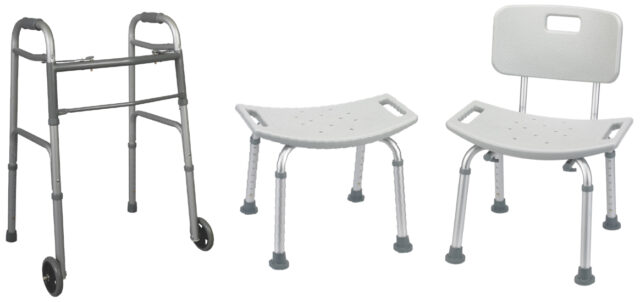
The time has come—you can no longer bear the joint pain or the detriment it has had on your life. You and your surgeon have decided that it is time to have your joint replaced. It is a huge decision, and you are not sure how to prepare for it. This article can help you prepare for the procedure and help make the process as smooth as possible.
Timeline to prepare for surgery
Optimize your health for surgery by visiting your primary care physician first. Within 2 months of the scheduled joint replacement, you should visit your primary care doctor and follow the recommendations to receive clearance for surgery. Clearance is important for lowering the risk of intraoperative or postoperative complications. The physician may schedule an electrocardiogram, or EKG (recording of the heart’s electrical rhythms), chest x-ray, and bloodwork. Once the doctor reviews the results, he or she will send them to the surgeon for review as well. Some patients are asked to complete a CT or MRI a few weeks prior to the surgery date. The surgeon may order the scan if you choose to have computer navigated or robotic assisted surgery.
Around 1 month before surgery, you should attend your hospital’s joint replacement class (if offered), and begin presurgery exercises. If you smoke, stop. Do not smoke 4 weeks before and after your surgery. Smoking slows healing, so avoid second hand smoke as well. If you need help with smoking cessation, your primary care provider should be able to provide additional support.
Helpful equipment
The surgeon often recommends adaptive equipment for patients to have on hand for their return home. For example, most doctors recommend a 2-wheeled walker—2 wheels in the front and 2 posts in the back—for hip and knee replacement patients. A 3-in-1 commode can be beneficial to place on top of the toilet or at bedside. It sits much higher than most household toilets and makes rising up easier with side handles. A bench, shower-chair, or the 3-in-1 commode can be used for sitting in the shower. The hospital usually provides a total joint kit to patients with some additional items, such as a reacher, sock-aid, long-handled shoehorn, or long-handled bath sponge. If recommended, obtain these items and communicate with your surgeon that you have these at your preoperative visit. Without this home equipment, you may have to stay unnecessarily in the hospital longer.
The preop visit
A preoperative appointment with your surgeon is required within 30 days of the surgery. This visit serves as a final checkup and a time for you to ask any remaining questions. At this visit, the surgeon may discuss any problems with bloodwork results and medical clearance notes; therefore, it is important that you have completed your preoperative clearance in plenty of time before this clinic appointment. After this visit, the medical team will send you to the hospital for a preadmission testing (PAT) appointment.
Medications
Be sure to tell your medical team about all medications you take, prescribed and over-the-counter. Supplements and vitamins count as medication too. Be sure to follow the surgeon’s specific instructions regarding your medications. For example, the surgeon may instruct you to stop taking certain medications before surgery, such as blood thinning medication. The surgeon may also ask that you stop taking any vitamins, supplements, herbal medication, aspirin, and nonsteroidal anti-inflammatory drugs (NSAIDs), such as ibuprofen, diclofenac, naproxen, Naprosyn®, Motrin®, Advil®, Aleve®, Mobic®, or Voltaren®.
Get your house in order
Prepare the house for your return before you go to the hospital. To help ease your return back home, it’s a good idea to do those household chores before surgery. Have all the cleaning and laundering complete. It is also helpful to have meals prepared and stored in the freezer for easy preparation when you get home.
Think about the safety aspects of your home, especially if you will be moving around with a walker. Remove throw rugs and tack down loose carpeting. Remove electrical cords and other obstructions from walkways. Install nightlights in bathrooms, bedrooms, and hallways. If necessary, arrange to have someone take care of your pets. Additionally, some patients find it helpful to set up a recovery area. In this area, place a bed, phone, TV remote, books, table for drinks, snacks, tissues, a wastebasket, and other items that you may need within a close distance.
What to bring to the hospital
The hospital will need a copy of your driver’s license or state-issued ID, a copy of your Advance Directives and insurance information. Also, bring your CPAP machine if you use one, and personal hygiene items, such as toothbrush, powder, deodorant, and glasses. Pack loose comfortable clothing to wear after surgery and gym-type clothes with athletic or closed back shoes for physical therapy. If the surgeon or hospital provided a medical information packet, bring that as well. Please be sure to leave valuables at home. There is no secure place to keep them at the hospital.
A day before surgery
The day before the surgery, shower using the antibacterial soap that the hospital gave you at the PAT appointment. You also need to pack your supplies for the hospital to alleviate the stress of leaving something behind. DO NOT EAT ANY FOOD after midnight. This is important because when the anaesthetic is used your body’s reflexes are temporary stopped. If you have food or drink in your stomach, there is a risk of vomiting. If this happens, the food could block your airway or it can enter your lungs causing damage.
The day of surgery
On the morning of the surgery, if your physician has told you to take specific medications, take it with a small sip of water. Wash the surgical site with the antibacterial soap for a second time, but DO NOT shave the surgical area. Brush your teeth and apply deodorant, but do not wear any makeup, perfume, lotions, powders, or oils on your chest, legs, or arms. If provided, drink the carbohydrate presurgery supplement at least 2 hours before the planned surgery. Arrive at the hospital 2 hours prior to your surgery time. The doctor and anesthesiologist will see you in the preoperative area before the surgery begins.
Going home
Most patients stay in the hospital between 1 to 2 days; however, depending on your type of surgery and mobility, you can be discharged home the same day as surgery. You must achieve several goals set by your medical team before you leave the hospital. Most patients go home directly after discharge; however, some patients may transfer to an inpatient rehabilitation center to help with recovery. Usually, a stay at an inpatient rehabilitation center is no longer than 2 weeks.
The first postoperative visit is usually 8 to 15 days after discharge, but can be longer if you are in a rehabilitation facility. The surgical dressing is usually changed for the first time at this appointment. The frequency of follow-up visits will depend on your progress. Most patients return to the clinic for x-rays and a check-up at 6 weeks, 12 weeks, 6 months, and at the 1-year anniversary of their procedure.
Author: Pasquale Reino, DO | Melbourne, Florida
Last edited on October 19, 2022



